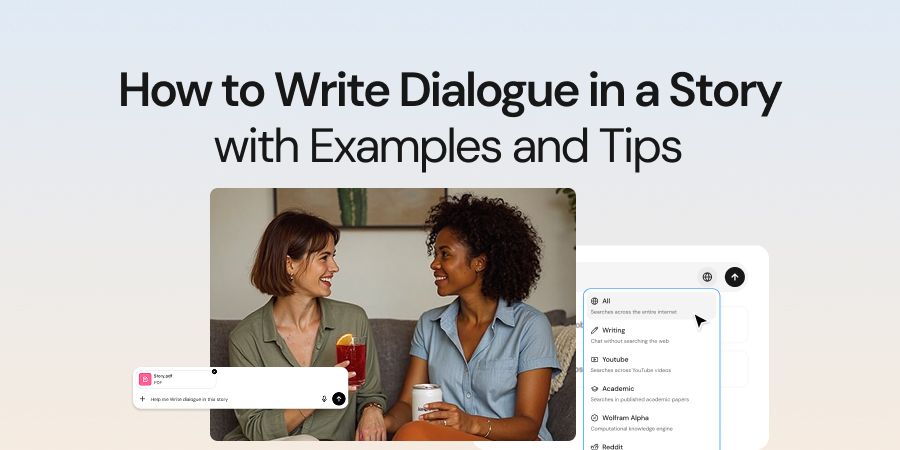
How to Write Dialogue in a Story with Examples and Tips
Conversations bring stories to life. They reveal how characters think, what they want, and how they respond to one another.
Without dialogue, even the most compelling plot risks feeling flat. Learning how to write dialogue in a story is a skill every writer must practice, because it shapes character interactions and keeps readers engaged.
Writers often wonder about the right way to begin whether they have to write a story, a speech, or even a memoir. A scene may start with description, but dialogue pulls the reader directly into the action.
And having a strong story is often the backbone of everything.
Knowing how to write dialogue in a short story or in a novel requires an understanding of rhythm, balance, and flow. When done well, conversations drive the story forward without ever feeling forced.
This guide covers everything you need to know about writing character interactions in fiction, from punctuation and formatting to creating natural conversations. You will also see examples of dialogue in writing that illustrate how words on the page can sound authentic.
Why Is Storytelling Important When Writing Conversations or Dialogue
Dialogue does more than fill space on the page. It builds tension, shows personality, and reveals relationships. Characters who speak in distinct voices feel real, and conversations between them create energy that pure narration cannot match.
Writers use dialogue to:
-
Reveal character motivations and conflicts
-
Break up long passages of description
-
Establish pace and rhythm in the scene
-
Deliver information in a natural way
-
Build relationships and dynamics between characters
When you learn how to write dialogue between two characters in a story, you gain control over pacing and tone. A sharp exchange can increase tension, while a quiet conversation can add intimacy. These choices give readers a reason to care about what happens next.
Mastering natural dialogue writing techniques also helps avoid stiff or artificial conversations. Readers can spot forced lines quickly, and that breaks immersion. Clear formatting, realistic speech patterns, and attention to subtext all work together to make dialogue believable.
If you are a fan of artificial intelligence, here are some of the best writing tools you want to explore.
Dialogue Formatting Basics and Punctuation
Strong conversations on the page need more than good ideas. Readers expect dialogue to be clear, easy to follow, and formatted correctly. Learning how to write dialogue in a story format is just as important as crafting what characters actually say. Poor formatting distracts, while clean structure lets the words flow.
Quotation Marks and Line Breaks
Each spoken line should appear within quotation marks. Every new speaker deserves a new line, making it simple for readers to follow who is talking.
For example:
-
“I thought you were coming earlier,” she said.
-
“Traffic was impossible,” he replied.
Learning how to punctuate dialogue in a story begins here. Quotation marks contain the speech, and line breaks keep exchanges clear.
Commas, Periods, and Question Marks
Dialogue tags like he said or she asked are connected to speech with commas, not periods. Punctuation always goes inside the quotation marks.
For instance:
-
“Are you leaving already?” she asked.
-
“Not until the morning,” he said.
Writers often ask specifically how to punctuate dialogue with a question mark. The answer is simple: the question mark replaces the comma or period, but the tag still follows in lowercase unless it’s a proper noun.
Formatting for Style and Flow
Readers should never stumble over formatting. Keep dialogue clean and uncluttered. Avoid adding too many exclamation marks or unusual symbols. A single exclamation can work, but stacking them weakens the impact.
Consistency across the manuscript shows polish and professionalism.
When you learn how to punctuate dialogue and apply it consistently, readers stay focused on the conversation itself.
Proper punctuation keeps rhythm natural, a lesson as valuable in storytelling as in structured writing guides such as how to write minutes of a meeting.
Techniques for Writing Natural Conversations
Good dialogue should sound like real speech without copying every pause or filler word. Writers who master natural dialogue writing techniques create conversations that feel alive, not mechanical. The challenge is making dialogue flow while still serving the story.
Listen to Real Speech
Pay attention to how people talk in everyday life. Real conversations use contractions, interruptions, and unfinished thoughts. Adding these details makes dialogue feel authentic. Compare:
-
Unrealistic: “I will not go to the market because I am too tired.”
-
Natural: “I’m not going to the market. Too tired.”
Short sentences, fragments, and rhythm matter more than perfect grammar when writing dialogue.
Avoid Info Dumps
Use Subtext
Not every line needs to say exactly what a character feels. Silence, hesitation, or indirect answers often speak louder than direct statements. Subtext creates tension and keeps readers curious.
A character might say, “It’s late, isn’t it?” instead of “I want you to leave now.”
Show Character Through Speech
The way characters talk reveals personality. One may use short, clipped sentences while another rambles with detail. Vocabulary, tone, and rhythm create a unique voice for each character. Learning how to write dialogue between two characters in a story means giving them distinct styles so readers can tell who is speaking without tags.
Balance with Examples
Reading examples of dialogue in writing helps sharpen skills. Compare stiff exchanges with natural ones. Notice how great authors use pauses, interruptions, or quick responses to reflect emotion. When you study how to write dialogue in a story example, you learn to shape conversations that feel as vivid as real life.
Dialogue Tags and Beats
Dialogue tags and beats guide the reader through conversations. They help identify who is speaking, add rhythm, and show action between lines of dialogue. Mastering these techniques is part of writing character interactions in fiction that feel smooth and believable.
Keep Tags Simple
Most of the time, the word said works best. It is invisible to the reader and keeps focus on the spoken words. Using too many creative tags like exclaimed, shouted, whispered loudly distracts from the dialogue itself. A tag should support, not overpower, the line.
Use Beats for Movement
A beat is a small piece of action that breaks up dialogue. Instead of always writing he said or she asked, you can show what the character is doing.
For example:
-
“I don’t trust him.” Sarah crossed her arms and stared at the floor.
-
“That’s your choice.” Mark picked up his bag and walked toward the door.
These beats give the conversation rhythm while adding physical context. They also replace repetitive tags, making dialogue cleaner.
Combine Dialogue with Emotion
Beats can reveal more than movement. Facial expressions, gestures, and subtle details show emotion without spelling it out. A clenched jaw tells the reader about anger, while fidgeting hands show nervousness. Strong beats layered into conversations build texture and authenticity.
Balance Tags, Beats, and Flow
Too many tags slow the pace, while too many beats can feel heavy. A balanced mix keeps readers engaged. When learning how to write dialogue in a story format, remember that clarity always comes first. Readers should never struggle to know who is speaking.
Examples in Practice
Consider this short exchange:
-
“We can’t stay here forever,” she said.
-
“I know.” He tapped his fingers against the table, eyes darting to the window.
This blend of tag and beat shows both tone and action. Studying examples of dialogue in writing like this helps you see how small choices influence the entire scene.
Common Mistakes to Avoid in Dialogue Writing
Writers often stumble when learning how to write dialogue in a story. Some mistakes make conversations feel stiff, while others confuse the reader. Avoiding these errors is just as important as learning the rules.
Over-Explaining Through Speech
Characters rarely speak in long, detailed explanations. Readers can tell when dialogue is being used to deliver backstory or research. This is called an “info dump,” and it makes speech sound unnatural. Keep explanations short and blend them with action or narration.
Suggested read: How to Write a One-Page Literature Review
Overusing Fancy Dialogue Tags
Exclaimed, shouted, whispered angrily, demanded fiercely. Too many decorative tags weigh down a scene. Readers start focusing on the tags instead of the words being spoken. Simple tags like said or asked usually work best. Strength should come from the dialogue itself.
Adding Adverbs to Every Line
He said loudly. She whispered softly. He asked nervously. Tags stuffed with adverbs weaken the writing. Replace them with beats or stronger word choice inside the dialogue.
For example:
-
Weak: “I don’t care,” she said angrily.
-
Strong: “I don’t care.” She slammed the door behind her.
Making Every Character Sound the Same
Distinct voices make conversations memorable. Without differences in vocabulary, rhythm, or tone, characters blur together. Practicing writing character interactions in fiction involves giving each speaker a unique style. One may use short clipped sentences, while another rambles with detail.
Ignoring Natural Flow
Real conversations involve interruptions, pauses, and unfinished thoughts. Writing dialogue as if it were polished speeches makes it feel artificial. Studying examples of dialogue in writing from published works helps you capture rhythm that feels true to life.
Forgetting the Reader’s Clarity
Dialogue should never leave the reader confused about who is speaking. Tags and beats provide clarity. If the reader has to guess, the conversation fails. Formatting, punctuation, and consistent attribution fix this problem before it appears.
Examples of Strong vs Weak Dialogue
Understanding theory is useful, but nothing teaches faster than looking at examples of dialogue in writing. Comparing weak lines with stronger revisions shows how subtle changes create realism and flow. These serve as direct how to write dialogue in a story examples for writers to study.
Weak vs Strong: Over-Explaining
-
Weak: “I am angry with you because you forgot to come home for dinner, and I had been waiting for hours.”
-
Strong: “You forgot dinner. I sat here waiting for hours.”
The stronger version trims unnecessary words and delivers impact through short, sharp sentences.
Weak vs Strong: Forced Emotion
-
Weak: “I do not want to see you ever again,” she shouted loudly with anger.
-
Strong: “Get out. Don’t come back.” Her voice cracked as she slammed the door.
The stronger version avoids cluttered tags and shows emotion through action.
Weak vs Strong: Identical Voices
-
Weak:
-
“I am going to the store. Would you like anything?”
-
“I am also going to the store. I will buy milk.”
-
-
Strong:
-
“I’ll grab milk while I’m out. Want anything else?”
-
“Chips. And don’t forget the coffee.”
-
The stronger version gives each character a distinct style and rhythm.
Weak vs Strong: Dialogue Without Context
-
Weak: “We should leave soon.” “Yes, I agree.”
-
Strong: “We should leave soon.” He glanced at the dark clouds gathering outside. “The storm’s almost here.”
The stronger version grounds dialogue in setting, adding atmosphere and urgency.
How Can Chatly Help in Dialogue Writing?
Chatly makes writing dialogue easier by giving you tools to create natural, realistic conversations. It combines AI Chat, AI Search, and multiple models in one place, so you can test ideas, check details, and refine lines quickly.
Ways Chatly Helps Writers
- AI Chat: Generate sample conversations between characters. You can adjust tone, style, and mood until it feels right.
- AI Search: Look up real phrases, slang, or professional language to keep dialogue authentic.
- Multiple Models: Switch between models like GPT-5, Claude, and Gemini to get different styles of dialogue and compare results.
Example Scenario for Dialogue Writing
You’re writing a scene between a lawyer and a client.
- Use AI Chat to draft the first version of the conversation.
- Use AI Search to ask AI how lawyers actually phrase advice in real life.
- Try different models to see one version that’s formal, another casual, and another with more emotional nuance.
This way, Chatly helps you create dialogue that sounds real, fits the characters, and moves the story forward.
Conclusion
Dialogue gives stories their pulse. It reveals character, controls rhythm, and keeps readers connected to the scene. Writers who master how to write dialogue in a story know how to balance speech with narration and make every voice distinct.
-
Use subtext to add meaning beyond the spoken words.
-
Blend internal and external dialogue in first person to show depth.
-
Leave silence or unanswered lines to build tension and realism.
Clarity and rhythm are what make conversations memorable. Knowing how to punctuate dialogue in a story keeps exchanges smooth, while practicing natural dialogue writing techniques helps avoid stiffness.
Studying examples of dialogue in writing sharpens instinct, showing which choices work and which do not.
Every scene is an opportunity to reveal emotion, conflict, or discovery. Dialogue is the tool that makes those moments last. With focus on detail and voice, conversations on the page become the lines readers remember long after the story is finished.
Frequently Asked Questions
Find the most frequent questions and their answers below.
More topics you may like

How to Write a Brand Collaboration Proposal in 2025

Muhammad Bin Habib

How to Write a Case Report in 2025

Muhammad Bin Habib

How to Write a Cover Letter with No Experience Using AI Chat

Muhammad Bin Habib

How to Write a Great Memoir: How to Start & Finish Your First Draft

Muhammad Bin Habib

11 Best ChatGPT Alternatives (Free & Paid) to Try in 2025 – Compare Top AI Chat Tools

Muhammad Bin Habib
